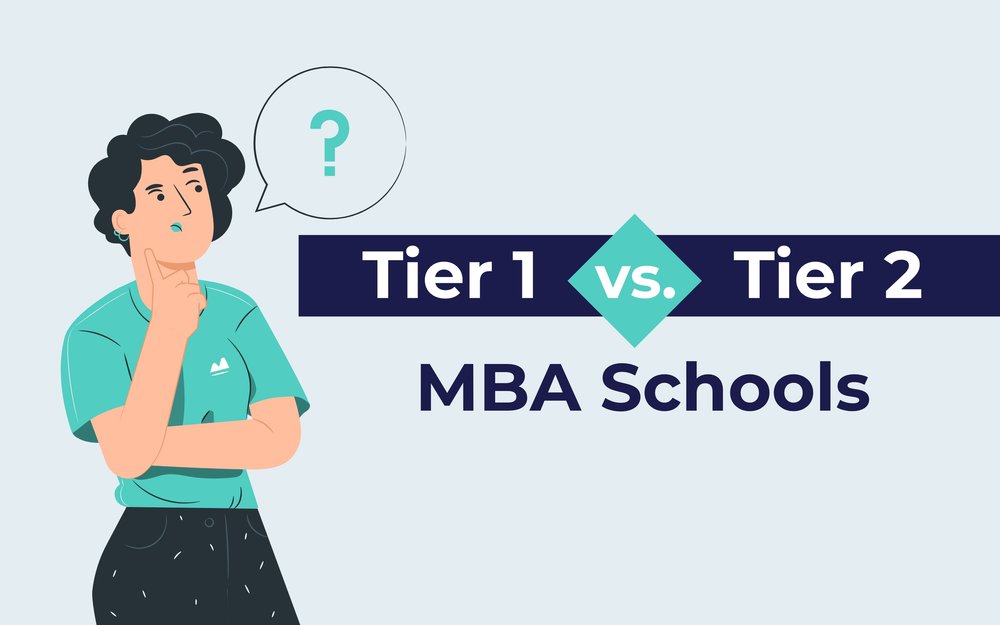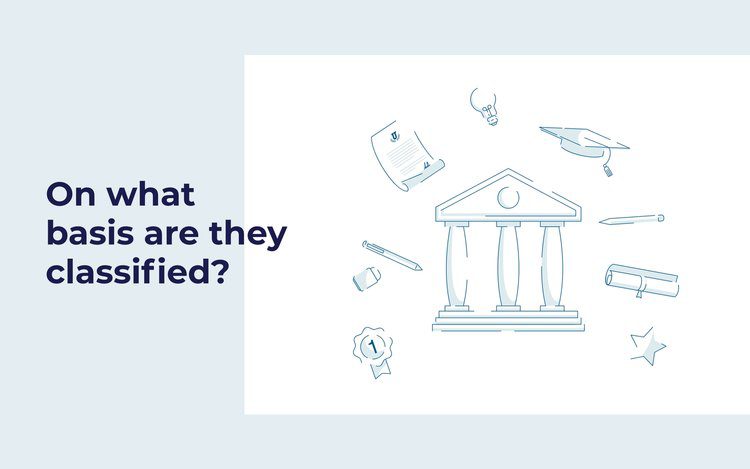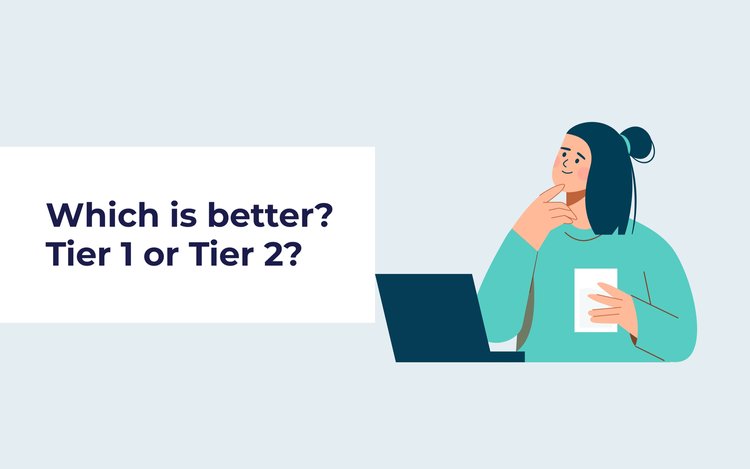Tier 1 vs. Tier 2 Business Schools

When candidates begin looking for colleges to apply to after graduating or acquiring professional experience, they face questions like, “Which college is suitable for me?” This is a challenging issue to respond to since what makes one institution ideal for one applicant may be disastrous for another. Tiers may have separated schools into two groups, but this is a good approach for candidates to decide if tier 1 or tier 2 is best for them. It’s crucial to note that these tiers aren’t meant to imply that one institution is better than another or that you need to go to a high-tier school to succeed in your career. Instead, these tiers show how tough it is to get into a particular college based on its admissions standards and which students have the highest chance of getting into which school based on their ability.
This article will explain and discuss the differences between tier 1 and tier 2 b schools and help you reach a conclusion, where you’ll better understand which one will fit your goals the best.
What is tier 1 and tier 2 school

TIER 1 – These schools have a reputation for cutting-edge research, academic quality, a diverse student body, and the highest levels of innovation, creativity, and scholarship. These schools have an admittance rate of less than 10%. Only ten out of every hundred applicants gain admission. These institutions actively seek candidates with strong academic performance and exceptional extracurricular achievements, viewing them as essential qualifications for consideration.
These are the most challenging colleges to get into, but that does not mean they are not accessible to all. It’s quite the opposite; they will be accessible to all students, including those with the highest qualifications. It does not imply that getting into elite colleges is unachievable; what we meant by unachievable is that the competition is very high, and chances of getting into these colleges are, therefore, less. It should never be considered a guarantee.
TIER 2 – Although not as much as tier 1 schools, these colleges are still quite challenging. They often have acceptance rates of less than 20%. Although they maintain equally high academic and extracurricular expectations, fewer students apply, giving each eligible applicant a better chance of acceptance.
Tier 2 b-schools, on the other hand, are elite institutions. Highly skilled students should consider these schools as targets, and most students should consider them as reachable schools, but applying to them isn’t always worthwhile. These institutions are frequently less well-known than tier 1 schools, yet they are no less challenging academically.
List of Top Tier 1 and Tier 2 B-Schools
| Tier 1 B-Schools | Tier 2 B-Schools |
|---|---|
| Stanford | USC |
| Harvard University | SDA Bocconi University |
| Wharton | Mc Combs |
| Yale | Foster School of Business |
| MIT | NYU |
| U Chicago | Tepper |
| Kellogg | UNC-Chapel Hill |
| Columbia | University of Michigan |
| Darden | Emory |
| Dartmouth | Notre Dame |
| Duke |
How are They Classified

Three organizations in the academic world are often regarded as national arbiters of an institution’s Tier One status. The Association of American Universities, the Carnegie Foundation for the Advancement of Teaching, and the Centre for Measuring University Performance, which publishes the Top American Research University (TARU) reports, are the three organizations. Tier One classification is determined if any of these three criteria are met.
Want to pursue an MBA but not sure if your profile fits?
Talk to our Profile Experts to know your chances for a top MBA Program.
GET A FREE PROFILE ANALYSISDetermining Tiers
When it comes to tiers, Tier 1 is the top 20, Tier 2 is the 21-50, and Tier 3 is the top 100. There are more category breakdowns in the top 20, but that’s the essence. Depending on whose rating you look at, who is in each category might be a point of contention.
Is it Necessary to Attend a Top 20 School (Tier1)
No, although they do have several benefits versus lower-level schools. As a result, they have greater global brand awareness, better networks, and higher beginning pay. If you want to work in a corporation as a VP or above level manager or in any high-powered role, you should try to get as high on the list as possible; top consultancy and finance firms hire from these tier 1 schools, making them the first target of the applicants.
When comparing tier 2 schools to tier 1 schools, it is often considered that the salary is less. This is partially correct. Starting pay decreases as one moves down the levels, although tuition remains constant. Tier 2 institutions are ideal for students who want to learn management but do not have management experience. A top 50 university would suffice, ascending the ladder steadily.
Overall, tier 1 schools provide a better level of growth in consultation, finance, and marketing. In contrast, tier 2 colleges offer the same but at a lower level when compared to tier 1.
What Is the Significance of Tier 1 B-Schools
It attests to a university’s greatness and will assist the country, area, and state economically and educationally. By increasing the number of Tier One institutions, communities may better compete for the finest and brightest students and faculty, promote economic growth, maintain an educated workforce, and attract innovative research.
According to economists, every $10 million spent on research creates more than 300 new jobs and adds more than $8 million to the local economy.
It’s important to emphasize that these tiers don’t suggest one institution is superior to another, nor do they imply that attending a top-tier school is essential for achieving success in your profession.
What Is the Acceptance Rate of Tier 1 and Tier 2 Schools
Tier 1 and Tier 2 B-schools lists with their average GMAT score as well listed below:
| Tier 1 B-Schools | Acceptance Rate | Average GMAT Score | Tier 2 B-Schools | Acceptance Rate | Average GMAT Score |
|---|---|---|---|---|---|
| Stanford | 5.2% | 738 | USC | 16.1% | 722 |
| Harvard | 5.0% | 740 | Foster School of Business | 16.0% | 700 |
| Wharton | 5.6% | 732 | Mc Combs | 16.3% | 704 |
| Yale | 5.4% | 730 | SDA Bocconi University | 11.1% | NA |
| MIT | 7.35 | 730 | NYU | 21.1% | 732 |
| University of Chicago | 7.3% | 729 | Boston University | 20% | 701 |
| Kellogg | 6.7% | 733 | UNC-Kenan Flagler | 25% | 696 |
| Columbia | 6.7% | 732 | University of Michigan | 26.1% | 728 |
| Darden | 8.0% | 718 | Tepper | 26.1% | 697 |
| Dartmouth | 9.2% | 727 | Notre Dame | 19% | 655(median) |
| Duke | 7.7% | 670-760 | Emory | 19.2% | 705 |
Placements of Tier 1 and Tier 2 B-Schools
| Tier 1 B-Schools | Tuition Fee ($) | Average Salary ($) | Tier 2 B-Schools | Tuition Fee ($) | Average Salary ($) |
|---|---|---|---|---|---|
| Stanford | 82,455 | 185,000 | USC | 79,893 | 144,442 |
| Harvard | 78,700 | 175,000 | Foster School of Business | 115,662 | NA |
| Wharton | 84,830 | 175,000 | Mc Combs | 119,368 | 150,000 |
| Yale | 87,800 | 160,000 | SDA Bocconi University | 82,000 EUR | 123,202 EUR |
| MIT | 84,350 | 170,000 | NYU | 86,916 | 175,000 |
| University of Chicago | 84,198 | 175,000 | Boston University | 66,670 | 120,000 |
| Kellogg | 83,610 | 170,000 | UNC-Kenan Flagler | 74,104 | 140,490 |
| Columbia | 88,300 | 175,000 | University of Michigan | 78,030 | 170,000 |
| Darden | 84,838 | 175,000 | Tepper | 78,362 | 189,275 |
| Dartmouth | 84,250 | 175,000 | Notre Dame | 73,260 | 130,000 |
| Duke | 81,000 | 175,000 | Emory | 153,800 | 175,000 |
Recruiters

Academics, infrastructure, faculty, research, placements, alumni network, and national/international presence are all factors that define tier 1 and tier 2 universities. So far, we’ve established that tier 1 colleges perform in all of the areas mentioned above. Still, it doesn’t mean that recruiters only target tier 1 schools; let’s take an example of top recruiters.
These are the top 5 top recruiters in the MBA industry: McKinsey & Company, Credit Suisse, Bain & Company, and Deutsche Bank. These recruiters hire from both tier 1 and tier 2 schools; the only difference is the pay scale; if you look at the table, you’ll notice that few tier 1 schools receive higher average salaries than tier 2 schools, and in some cases, the opposite is true.
Learn more about the best recruiters for B-schools: Top 5 MBA Recruiters
What to Target, Tier 1 or Tier 2

The tiers are not meant to be conclusive; instead, they’re intended to help you decide which schools to apply to and which ones you have the highest chance of being accepted to.
Yes, college tiers are important if you want to work in academics. However, depending on your job options, they’ll take second to other considerations, such as your financial situation. So don’t be swayed just by advertising. Do your homework and apply to the institutions and universities that will provide you with the most value for your money.
Think again before making a decision, but if you’re still unclear which tier is best for you, schedule a call with us to receive a free profile evaluation and learn about the weaknesses in your profile, which will help you better understand which schools to target.
Frequently Asked Questions
1.
What is the difference between Tier 1 and Tier 2 Business schools
Tier 1 schools are known for cutting-edge research, academic excellence, diverse student bodies, and high innovation, creativity, and scholarship. Tier 2 schools, on the other hand, these colleges are demanding but not as hard as tier one schools. They frequently have acceptance rates of less than a quarter of a percent. While they have the same academic and extracurricular standards, some fewer students apply. Thus each eligible kid has a higher chance of being accepted.
2.
Is Tier 1 or 2 better
Tiers may have divided schools into two categories, but this is an effective method for applicants to determine if tier 1 or tier 2 is the greatest fit for them. It’s important to note that these tiers aren’t designed to indicate that one institution is superior to another or that you need to attend a top-tier school to be successful in your profession. Instead, these levels demonstrate how difficult it is to get into a specific institution based on its admissions criteria and which students have the best chance of getting into which school based on their academic abilities.
3.
How do acceptance rates and average GMAT scores compare between Tier 1 and Tier 2 schools?
Tier 1 schools typically have acceptance rates below 10% and average GMAT scores around 730 or higher. Tier 2 schools often have acceptance rates ranging from 10% to 20%, with average GMAT scores slightly lower, depending on the institution.
4.
What factors should I consider when choosing between Tier 1 and Tier 2 business schools?
Consider your career objectives, desired industry, geographic preferences, financial investment, and personal circumstances. Assess how each school’s strengths align with your goals, and evaluate factors like curriculum focus, alumni network, and placement records.




Leave a Reply